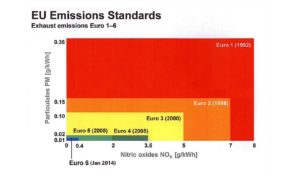
Saad Malik argues that it is time to stop blaming our neighbours for the smog and take actions such as curtailing population growth and reducing vehicle emissions to deal with the menace that threatens us year after year.
As winters approach, a familiar foe is back with reckoning. A thick blanket of poisonous smog engulfs eastern cities of Pakistan, especially Lahore, transforming the city of Gardens into one huge gas chamber and slowly poisoning its residents to death. With Lahore’s AQI (air quality index) numbers registering 5-6 times above the healthy limit and occasionally going to apocalyptic levels, a familiar discussion is back. Like all other problems, our pollution problem is also conveniently blamed on neighboring India with crop stubble burning and Diwali fireworks being held as the chief protagonists.
Even before people became aware of smog AQI and the health issues this situation poses, India was long blamed for ‘fog’ due to the emissions of its coal-based power plants, even in the mid-2000’s. While India is no saint when it comes to its carbon footprint, there are a few caveats with this argument.
According to a report in Dawn titled ‘Pakistan’s own pollution causes smog, say experts’, experts, including Dr Imran Khalid, head of Environment and Climate Change Department at the Sustainable Development Policy Institute, Islamabad, blame the vehicular and transport-based emissions as the main culprit for the poor air quality, with 43% of all emissions being sourced to transport-based machinery and equipment.
Two major factors are contributing to this apocalyptic condition, neither of which can be blamed on India. The first is our bludgeoning population. Amongst other issues that we’re likely to encounter including water scarcity, air pollution is another major disaster that is increasingly making life difficult in our part of the world due to unsustainable population growth.
Policy makers need to adopt short-term and long-term measures to overcome this hurdle to keep our cities sustainable. Amongst the most efficient short-term measures is to invest in mass transit infrastructure to curtail the emissions. Mass transit options will not only ease the burden of traffic on the roads but also cut down the per capita carbon footprint. This can be more successful if instead of combustion engine-based vehicles, our state invests in electric vehicles. Not only will this be environmentally efficient but will also help to positively utilise our electricity production capacity, which experts agree is sufficient to cater to our needs for at least the next 11 years.
The long-term measure has to be a focus on curtailing population growth rates. If our country continues to grow at the present population growth rate, air pollution will not be the only problem our future generations will be facing. Food and water scarcity will hit this region hard, considering the fact that climate change is already wreaking havoc. These conditions coupled with poor air quality have led to all five major crops delivering a below par yield in 2019.
This trend will turn the living conditions even more miserable if our population continues to multiply at this unsustainable rate resulting in more mouths to feed, fueling demand for more hospital beds, more college degrees and eventually more unemployed youth looking for jobs who would eventually turn to illegal migration or a life of crime.

The other major long-term measure has to be focused on reducing our vehicular emissions. While the world swiftly moves towards banning diesel engines and replacing with electric vehicles, our part of the world still struggles to bring the emission levels to sustainable levels. The fuel widely available barely complies to the Euro 2 standard, while the world has moved on to Euro 6; catalytic converters are still a novelty in Pakistan with most cars running without them. To put things in perspective, Euro 2 compliant diesel emits 0.15 grams of Nitric oxides (NOx) per kWh compared to 0.01grams NOx/kWh for Euro 6 compliant vehicles.
Upgrading our fuel standards and implementing a strict check and balance on vehicle fitness could help curtail and fix the situation in the short and long term. While the government has taken steps by introducing electric vehicle policy, it is unlikely to have a major impact considering that auto sales have been falling for over a year now and are unlikely to pick up anytime soon.
Electric Vehicles (EV) are more expensive internationally, so a shift at the consumer level is unlikely to happen unless the government announces some serious incentives for the user. Along with that, the menace of emissions from transport vehicles and buses needs to be tackled on a priority basis. Not only has it ruined the air quality for the residents of Punjab, the AQI of Peshawar too is showing signs of touching hazardous levels. Glacial Lake Outburst Floods are becoming less rare in recent years and experts blame the emissions of transport vehicles especially for the catastrophe that occurred near Chitral.
While a lack of tree cover and crop stubble burning are significant contributing factors, these two factors cannot be fixed in the short-term. In fact, trees are unable to filter PM 2.5 particles (the single most dangerous component of the smog), therefore we need to work around with whatever we can instead of indulging in a blame game.
135,000 people in Pakistan die due to respiratory related illnesses. A resident of Lahore can lose up to 2 years of his life expectancy due to the toxic air they’re breathing in every day. So, instead of allowing the problematic situation to transform into a catastrophe where people start mass migrating out of Lahore, creating an economic and humanitarian nightmare, it is easier to replace old gas guzzling engines.
As winters approach, a familiar foe is back with reckoning. A thick blanket of poisonous smog engulfs eastern cities of Pakistan, especially Lahore, transforming the city of Gardens into one huge gas chamber and slowly poisoning its residents to death. With Lahore’s AQI (air quality index) numbers registering 5-6 times above the healthy limit and occasionally going to apocalyptic levels, a familiar discussion is back. Like all other problems, our pollution problem is also conveniently blamed on neighboring India with crop stubble burning and Diwali fireworks being held as the chief protagonists.
Even before people became aware of smog AQI and the health issues this situation poses, India was long blamed for ‘fog’ due to the emissions of its coal-based power plants, even in the mid-2000’s. While India is no saint when it comes to its carbon footprint, there are a few caveats with this argument.
According to a report in Dawn titled ‘Pakistan’s own pollution causes smog, say experts’, experts, including Dr Imran Khalid, head of Environment and Climate Change Department at the Sustainable Development Policy Institute, Islamabad, blame the vehicular and transport-based emissions as the main culprit for the poor air quality, with 43% of all emissions being sourced to transport-based machinery and equipment.
Two major factors are contributing to this apocalyptic condition, neither of which can be blamed on India. The first is our bludgeoning population. Amongst other issues that we’re likely to encounter including water scarcity, air pollution is another major disaster that is increasingly making life difficult in our part of the world due to unsustainable population growth.
Policy makers need to adopt short-term and long-term measures to overcome this hurdle to keep our cities sustainable. Amongst the most efficient short-term measures is to invest in mass transit infrastructure to curtail the emissions. Mass transit options will not only ease the burden of traffic on the roads but also cut down the per capita carbon footprint. This can be more successful if instead of combustion engine-based vehicles, our state invests in electric vehicles. Not only will this be environmentally efficient but will also help to positively utilise our electricity production capacity, which experts agree is sufficient to cater to our needs for at least the next 11 years.
The long-term measure has to be a focus on curtailing population growth rates. If our country continues to grow at the present population growth rate, air pollution will not be the only problem our future generations will be facing. Food and water scarcity will hit this region hard, considering the fact that climate change is already wreaking havoc. These conditions coupled with poor air quality have led to all five major crops delivering a below par yield in 2019.
This trend will turn the living conditions even more miserable if our population continues to multiply at this unsustainable rate resulting in more mouths to feed, fueling demand for more hospital beds, more college degrees and eventually more unemployed youth looking for jobs who would eventually turn to illegal migration or a life of crime.

Source: http://www.dougjack.co.uk/bus-industry-euro-6-emissions-limits.html
The other major long-term measure has to be focused on reducing our vehicular emissions. While the world swiftly moves towards banning diesel engines and replacing with electric vehicles, our part of the world still struggles to bring the emission levels to sustainable levels. The fuel widely available barely complies to the Euro 2 standard, while the world has moved on to Euro 6; catalytic converters are still a novelty in Pakistan with most cars running without them. To put things in perspective, Euro 2 compliant diesel emits 0.15 grams of Nitric oxides (NOx) per kWh compared to 0.01grams NOx/kWh for Euro 6 compliant vehicles.
Upgrading our fuel standards and implementing a strict check and balance on vehicle fitness could help curtail and fix the situation in the short and long term. While the government has taken steps by introducing electric vehicle policy, it is unlikely to have a major impact considering that auto sales have been falling for over a year now and are unlikely to pick up anytime soon.
Electric Vehicles (EV) are more expensive internationally, so a shift at the consumer level is unlikely to happen unless the government announces some serious incentives for the user. Along with that, the menace of emissions from transport vehicles and buses needs to be tackled on a priority basis. Not only has it ruined the air quality for the residents of Punjab, the AQI of Peshawar too is showing signs of touching hazardous levels. Glacial Lake Outburst Floods are becoming less rare in recent years and experts blame the emissions of transport vehicles especially for the catastrophe that occurred near Chitral.
While a lack of tree cover and crop stubble burning are significant contributing factors, these two factors cannot be fixed in the short-term. In fact, trees are unable to filter PM 2.5 particles (the single most dangerous component of the smog), therefore we need to work around with whatever we can instead of indulging in a blame game.
135,000 people in Pakistan die due to respiratory related illnesses. A resident of Lahore can lose up to 2 years of his life expectancy due to the toxic air they’re breathing in every day. So, instead of allowing the problematic situation to transform into a catastrophe where people start mass migrating out of Lahore, creating an economic and humanitarian nightmare, it is easier to replace old gas guzzling engines.
